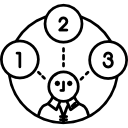Programming: Difference between revisions
Mr. MacKenty (talk | contribs) No edit summary |
Mr. MacKenty (talk | contribs) No edit summary |
||
| Line 1: | Line 1: | ||
[[file:computation.png|right|frame|Programming<ref>http://www.flaticon.com/</ref>]] | [[file:computation.png|right|frame|Programming<ref>http://www.flaticon.com/</ref>]] | ||
Revision as of 13:37, 16 June 2019

Programming[1]
Introduction to programming[edit]
Programming is the issuing of instructions to a computer. You must learn how to issue instructions to a computer.
Basic understanding[edit]
Primitive data types[edit]
In computer science and computer programming, a data type or simply type is a classification of data which tells the compiler or interpreter how the programmer intends to use the data. Most programming languages support various types of data, for example: real, integer or Boolean.[2]
The list below describes some of the more common primitive data types
Common data structures[edit]
Control Flow[edit]
In computer science, control flow (or flow of control) is the order in which individual statements, instructions or function calls of an imperative program are executed or evaluated. [3]
Basic program organization[edit]